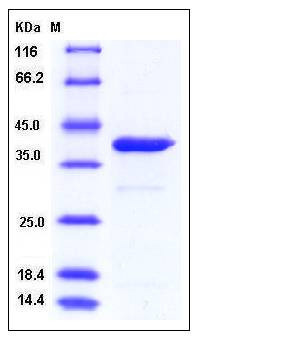Human ARG1 / Arginase 1 Protein (His Tag)
ARG1
- 100ug (NPP3583) Please inquiry
| Catalog Number | P11558-H08H |
|---|---|
| Organism Species | Human |
| Host | Human Cells |
| Synonyms | ARG1 |
| Molecular Weight | The secreted recombinant human ARG1 consists of 333 amino acids and has a calculated molecular mass of 36.2 kDa. The apparent molecular mass of the protein is approximately 40 kDa in SDS-PAGE under reducing conditions. |
| predicted N | Met 1 |
| SDS-PAGE |  |
| Purity | > 90 % as determined by SDS-PAGE |
| Protein Construction | A DNA sequence encoding the human ARG1 isoform 1 (P05089-1) (Met 1-Lys 322) was fused with a polyhistidine tag at the C-terminus. |
| Bio-activity | Measured by the production of urea during the hydrolysis of arginine. The specific activity is >35,000 pmoles/min/μg. |
| Research Area | Cancer |Signal transduction |Metabolism |Types of disease |Metabolism in Cancer |
| Formulation | Lyophilized from sterile 20mM Tris, 150mM NaCl, 20% Glycerol, 1mM DTT, pH 7.4 1. Normally 5 % - 8 % trehalose and mannitol are added as protectants before lyophilization. Specific concentrations are included in the hardcopy of COA. |
| Background | Arginase is the focal enzyme of the urea cycle hydrolysing L-arginine to urea and L-ornithine. Emerging studies have identified arginase in the vasculature and have implicated this enzyme in the regulation of nitric oxide (NO) synthesis and the development of vascular disease. Arginase also redirects the metabolism of L-arginine to L-ornithine and the formation of polyamines and L-proline, which are essential for smooth muscle cell growth and collagen synthesis. Arginase is encoded by two recently discovered genes (Arginase I and Arginase II). In most mammals, Arginase 1 (ARG1) also known as Arginase, liver, which functions in the urea cycle, and is located primarily in the cytoplasm of the liver. The second isozyme, Arginase II, has been implicated in the regulation of the arginine/ornithine concentrations in the cell. It is located in mitochondria of several tissues in the body, with most abundance in the kidney and prostate. It may be found at lower levels in macrophages, lactating mammary glands, and brain. |
| Reference |
